|
|
The Champa Museum in Đà Nẵng
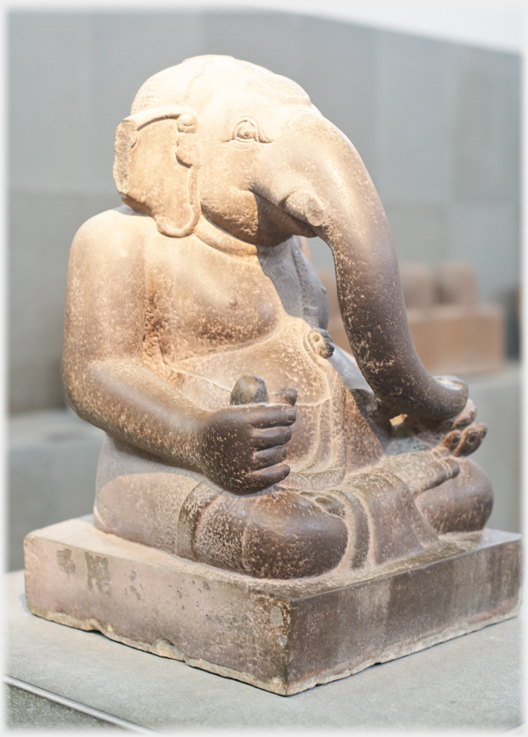 Meeting a statue of Ganesha, the Indian god of wisdom and much more, on the coast of the China sea is as surprising as it would be by the Atlantic. But this is the country of the Champas whose broadly Hindu religion flourished here for a thousand years
Meeting a statue of Ganesha, the Indian god of wisdom and much more, on the coast of the China sea is as surprising as it would be by the Atlantic. But this is the country of the Champas whose broadly Hindu religion flourished here for a thousand years
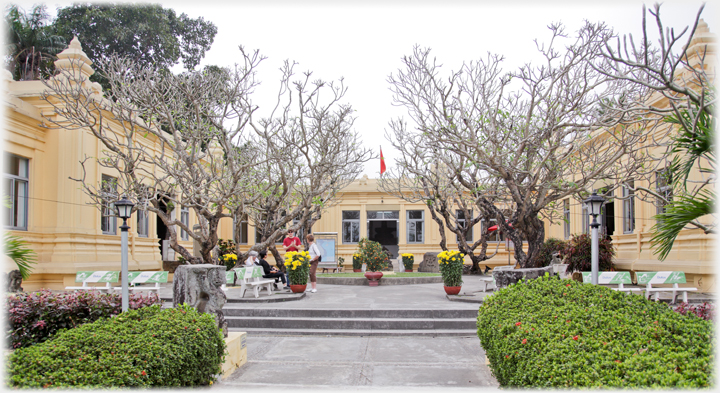 Main entrance of the Champa Museum which was opened in 1919 on a site where Champa sculptures had been gathered in the early twentieth century
The artefacts of the Champa Kingdom are fascinating for the way the Hindu culture from the west, blended with the Chinese aesthetic, and produced works of great simplicity and dignity. The Champa Museum in Đà Nẵng is where many of these works are displayed. Mostly they come from the nearby Mỹ Sơn site (pronounced a bit like 'Mihi Sern'). The upper floor of the museum also has a collection of non-Champa items.
Main entrance of the Champa Museum which was opened in 1919 on a site where Champa sculptures had been gathered in the early twentieth century
The artefacts of the Champa Kingdom are fascinating for the way the Hindu culture from the west, blended with the Chinese aesthetic, and produced works of great simplicity and dignity. The Champa Museum in Đà Nẵng is where many of these works are displayed. Mostly they come from the nearby Mỹ Sơn site (pronounced a bit like 'Mihi Sern'). The upper floor of the museum also has a collection of non-Champa items.
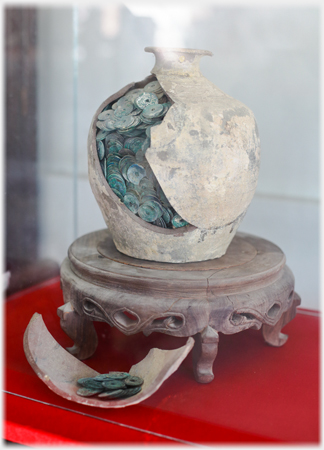 A pot of coins recovered from a shipwreck of 400 years ago
A pot of coins recovered from a shipwreck of 400 years ago
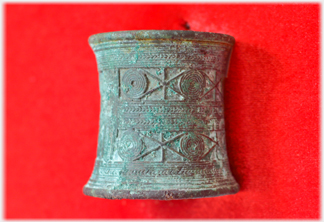 Dating from the Đông Sơn culture (2,500-2,000 years ago), a soldier's Bronze Armlet
Dating from the Đông Sơn culture (2,500-2,000 years ago), a soldier's Bronze Armlet
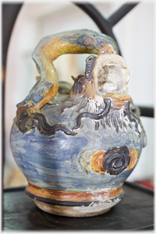 An eighteenth century painted jug
An eighteenth century painted jug
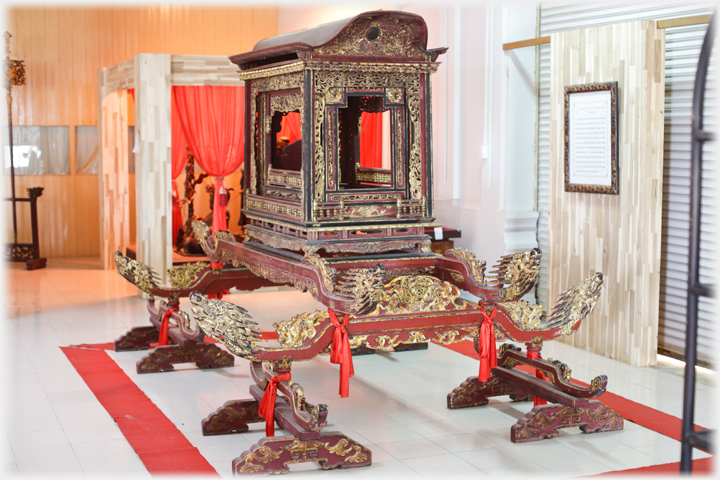 This nineteenth century Sedan chair replete with many dragons
This nineteenth century Sedan chair replete with many dragons
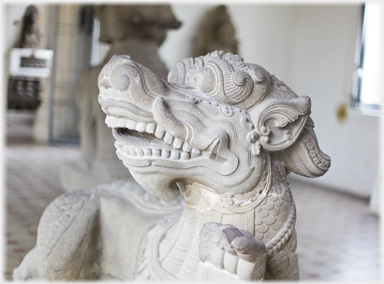 Dragons, the first thing one would expect...
Dragons, the first thing one would expect...
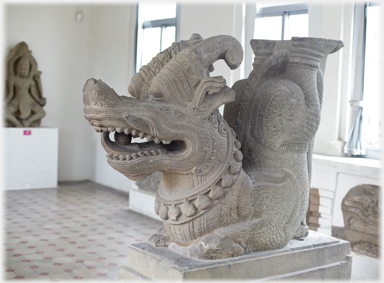 ...of an East Asian sculpture gallery
...of an East Asian sculpture gallery
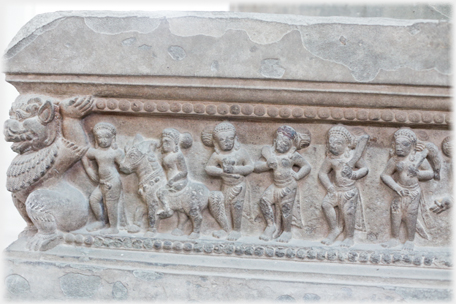 And then, unexpectedly, a pedestal carved in the tenth century in the Champa Mỹ Sơn style with dragon-like figures...
And then, unexpectedly, a pedestal carved in the tenth century in the Champa Mỹ Sơn style with dragon-like figures...
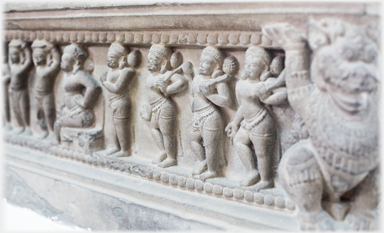 ...combined with slightly plump Indian style people
This meeting and, in places, merging of cultures is what makes the Champa carvings so special: some surfaces are covered by elaborate decoration, others are smooth and simple with dragons on guard
...combined with slightly plump Indian style people
This meeting and, in places, merging of cultures is what makes the Champa carvings so special: some surfaces are covered by elaborate decoration, others are smooth and simple with dragons on guard
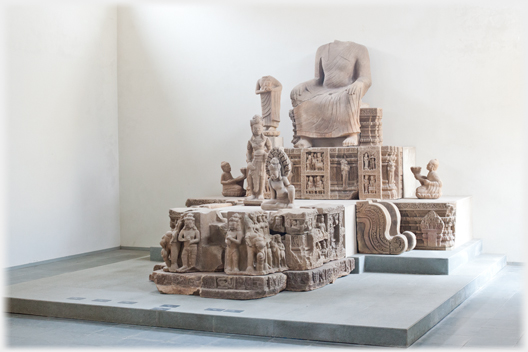 These Champa carvings from around 900 CE have been reassembled into what was probably their original positions, they have a seated Buddha (simply attired) attended by a monk and a Bodhisattva...
These Champa carvings from around 900 CE have been reassembled into what was probably their original positions, they have a seated Buddha (simply attired) attended by a monk and a Bodhisattva...
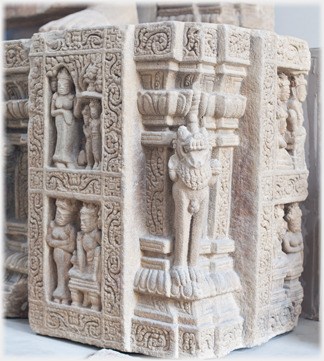 ...on platforms which have intricate Hindu style supports
...on platforms which have intricate Hindu style supports
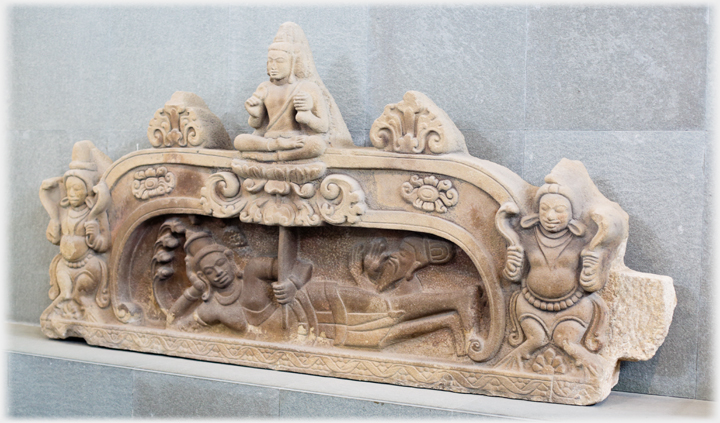 This Mỹ Sơn style carving shows that most Hindu of themes: Vishnu reclining and the birth of Brahma, it dates from the second half of the seventh century
This Mỹ Sơn style carving shows that most Hindu of themes: Vishnu reclining and the birth of Brahma, it dates from the second half of the seventh century
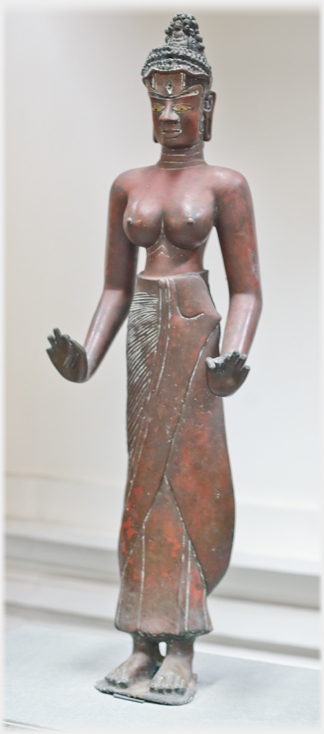 A bronze statue from about 900 CE which (probably) shows Tara the Hindu goddess of protection. She retains her elaborate headdress...
A bronze statue from about 900 CE which (probably) shows Tara the Hindu goddess of protection. She retains her elaborate headdress...
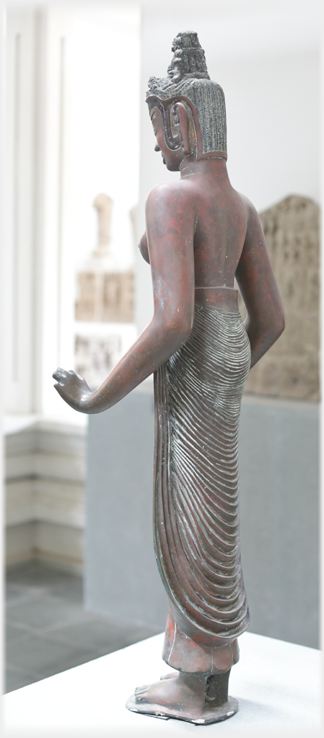 ...and emphasised endowment, but unlike her Indian representations the lines of her dress are simple
...and emphasised endowment, but unlike her Indian representations the lines of her dress are simple
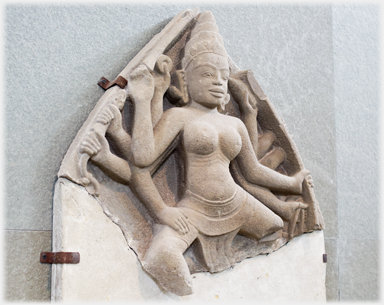 The multiple arms of a Hindu goddess expressing her power to do many things at once
The multiple arms of a Hindu goddess expressing her power to do many things at once
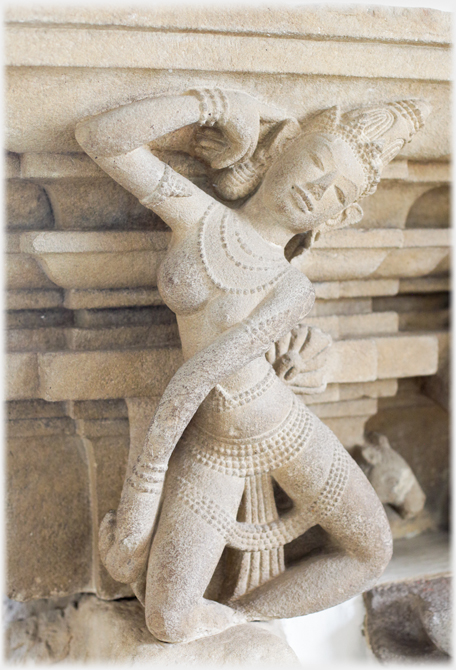 Apsara, the Female spirit of clouds and water, dancing in a tenth century Cham sculpture
Apsara, the Female spirit of clouds and water, dancing in a tenth century Cham sculpture
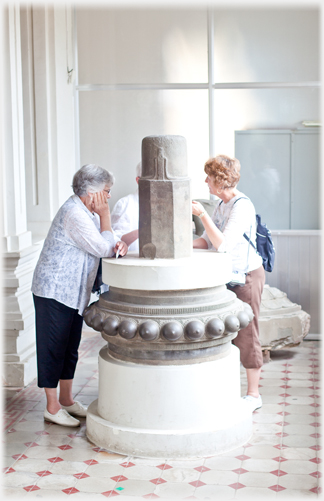 One wonders if these American visitors are aware of quite what they are stroking! This lingam (with a base decorated with breasts) is one of many found at the Mỹ Sơn site
One wonders if these American visitors are aware of quite what they are stroking! This lingam (with a base decorated with breasts) is one of many found at the Mỹ Sơn site
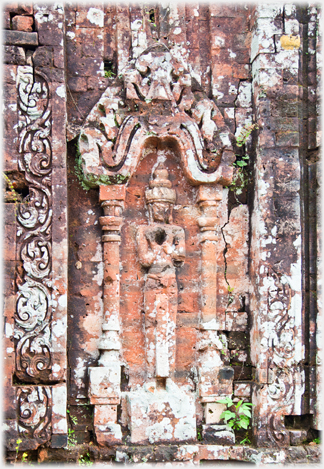 This carving is still in situ at Mỹ Sơn, it is formed from the bricks out of which the temples are constructed
This carving is still in situ at Mỹ Sơn, it is formed from the bricks out of which the temples are constructed
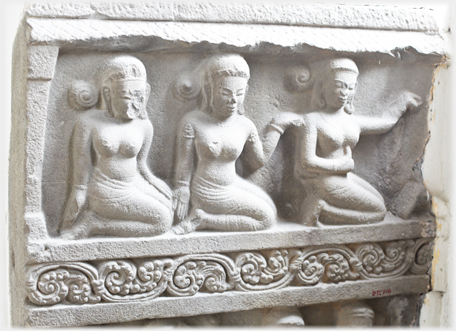 Dancers with hands working Thai style
Dancers with hands working Thai style
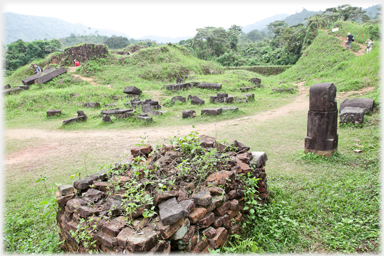 One of the lingam still at the Mỹ Sơn site
The word Champa is used to refer to the various sea-orientated principalities that existed on the east coast of Vietnam from around the second to the nineteenth centuries. They reached the height of the influence in the tenth century after which pressure from the Viet to the north eroded their power. Mỹ Sơn is some 45 kilometres to the south-east of Đà Nẵng and was a major religious centre for the Champas from the fourth to the fourteenth centuries.
One of the lingam still at the Mỹ Sơn site
The word Champa is used to refer to the various sea-orientated principalities that existed on the east coast of Vietnam from around the second to the nineteenth centuries. They reached the height of the influence in the tenth century after which pressure from the Viet to the north eroded their power. Mỹ Sơn is some 45 kilometres to the south-east of Đà Nẵng and was a major religious centre for the Champas from the fourth to the fourteenth centuries.
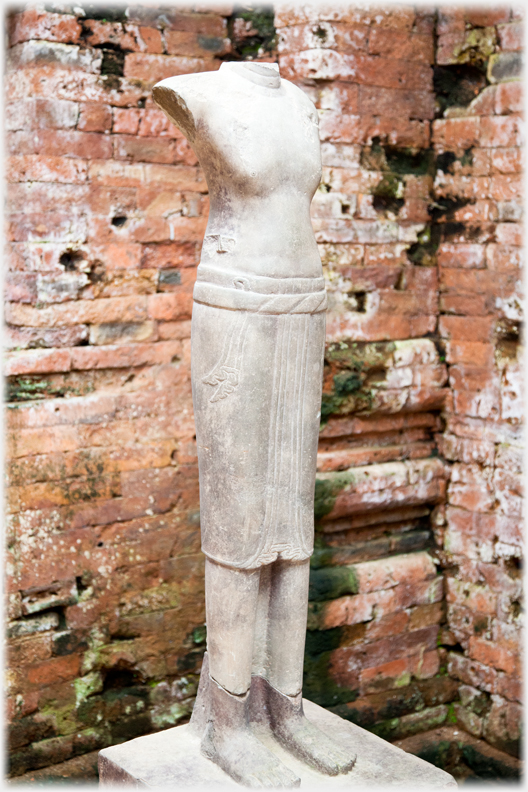 The meeting of Hindu and Chinese aesthetic is summed up in this statue kept at Mỹ Sơn, traces of the Hindu god reduced to complete simplicity
The next page
goes to the Mỹ Sơn site, largely overgrown by tropical jungle, and having limited access because of ordnance remains from wars - and so made all the more tantalising.
The meeting of Hindu and Chinese aesthetic is summed up in this statue kept at Mỹ Sơn, traces of the Hindu god reduced to complete simplicity
The next page
goes to the Mỹ Sơn site, largely overgrown by tropical jungle, and having limited access because of ordnance remains from wars - and so made all the more tantalising.
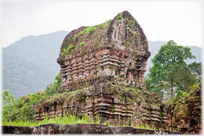

Saturday 1st April 2017

Go to the Picture Posting contents page
Return to the top
|
|
 Meeting a statue of Ganesha, the Indian god of wisdom and much more, on the coast of the China sea is as surprising as it would be by the Atlantic. But this is the country of the Champas whose broadly Hindu religion flourished here for a thousand years
Meeting a statue of Ganesha, the Indian god of wisdom and much more, on the coast of the China sea is as surprising as it would be by the Atlantic. But this is the country of the Champas whose broadly Hindu religion flourished here for a thousand years
 Main entrance of the Champa Museum which was opened in 1919 on a site where Champa sculptures had been gathered in the early twentieth century
The artefacts of the Champa Kingdom are fascinating for the way the Hindu culture from the west, blended with the Chinese aesthetic, and produced works of great simplicity and dignity. The Champa Museum in Đà Nẵng is where many of these works are displayed. Mostly they come from the nearby Mỹ Sơn site (pronounced a bit like 'Mihi Sern'). The upper floor of the museum also has a collection of non-Champa items.
Main entrance of the Champa Museum which was opened in 1919 on a site where Champa sculptures had been gathered in the early twentieth century
The artefacts of the Champa Kingdom are fascinating for the way the Hindu culture from the west, blended with the Chinese aesthetic, and produced works of great simplicity and dignity. The Champa Museum in Đà Nẵng is where many of these works are displayed. Mostly they come from the nearby Mỹ Sơn site (pronounced a bit like 'Mihi Sern'). The upper floor of the museum also has a collection of non-Champa items.
 A pot of coins recovered from a shipwreck of 400 years ago
A pot of coins recovered from a shipwreck of 400 years ago
 Dating from the Đông Sơn culture (2,500-2,000 years ago), a soldier's Bronze Armlet
Dating from the Đông Sơn culture (2,500-2,000 years ago), a soldier's Bronze Armlet
 An eighteenth century painted jug
An eighteenth century painted jug
 This nineteenth century Sedan chair replete with many dragons
This nineteenth century Sedan chair replete with many dragons
 Dragons, the first thing one would expect...
Dragons, the first thing one would expect...
 ...of an East Asian sculpture gallery
...of an East Asian sculpture gallery
 And then, unexpectedly, a pedestal carved in the tenth century in the Champa Mỹ Sơn style with dragon-like figures...
And then, unexpectedly, a pedestal carved in the tenth century in the Champa Mỹ Sơn style with dragon-like figures...
 ...combined with slightly plump Indian style people
This meeting and, in places, merging of cultures is what makes the Champa carvings so special: some surfaces are covered by elaborate decoration, others are smooth and simple with dragons on guard
...combined with slightly plump Indian style people
This meeting and, in places, merging of cultures is what makes the Champa carvings so special: some surfaces are covered by elaborate decoration, others are smooth and simple with dragons on guard
 These Champa carvings from around 900 CE have been reassembled into what was probably their original positions, they have a seated Buddha (simply attired) attended by a monk and a Bodhisattva...
These Champa carvings from around 900 CE have been reassembled into what was probably their original positions, they have a seated Buddha (simply attired) attended by a monk and a Bodhisattva...
 ...on platforms which have intricate Hindu style supports
...on platforms which have intricate Hindu style supports
 This Mỹ Sơn style carving shows that most Hindu of themes: Vishnu reclining and the birth of Brahma, it dates from the second half of the seventh century
This Mỹ Sơn style carving shows that most Hindu of themes: Vishnu reclining and the birth of Brahma, it dates from the second half of the seventh century
 A bronze statue from about 900 CE which (probably) shows Tara the Hindu goddess of protection. She retains her elaborate headdress...
A bronze statue from about 900 CE which (probably) shows Tara the Hindu goddess of protection. She retains her elaborate headdress...
 ...and emphasised endowment, but unlike her Indian representations the lines of her dress are simple
...and emphasised endowment, but unlike her Indian representations the lines of her dress are simple
 The multiple arms of a Hindu goddess expressing her power to do many things at once
The multiple arms of a Hindu goddess expressing her power to do many things at once
 Apsara, the Female spirit of clouds and water, dancing in a tenth century Cham sculpture
Apsara, the Female spirit of clouds and water, dancing in a tenth century Cham sculpture
 One wonders if these American visitors are aware of quite what they are stroking! This lingam (with a base decorated with breasts) is one of many found at the Mỹ Sơn site
One wonders if these American visitors are aware of quite what they are stroking! This lingam (with a base decorated with breasts) is one of many found at the Mỹ Sơn site
 This carving is still in situ at Mỹ Sơn, it is formed from the bricks out of which the temples are constructed
This carving is still in situ at Mỹ Sơn, it is formed from the bricks out of which the temples are constructed
 Dancers with hands working Thai style
Dancers with hands working Thai style
 One of the lingam still at the Mỹ Sơn site
The word Champa is used to refer to the various sea-orientated principalities that existed on the east coast of Vietnam from around the second to the nineteenth centuries. They reached the height of the influence in the tenth century after which pressure from the Viet to the north eroded their power. Mỹ Sơn is some 45 kilometres to the south-east of Đà Nẵng and was a major religious centre for the Champas from the fourth to the fourteenth centuries.
One of the lingam still at the Mỹ Sơn site
The word Champa is used to refer to the various sea-orientated principalities that existed on the east coast of Vietnam from around the second to the nineteenth centuries. They reached the height of the influence in the tenth century after which pressure from the Viet to the north eroded their power. Mỹ Sơn is some 45 kilometres to the south-east of Đà Nẵng and was a major religious centre for the Champas from the fourth to the fourteenth centuries.
 The meeting of Hindu and Chinese aesthetic is summed up in this statue kept at Mỹ Sơn, traces of the Hindu god reduced to complete simplicity
The next page
goes to the Mỹ Sơn site, largely overgrown by tropical jungle, and having limited access because of ordnance remains from wars - and so made all the more tantalising.
The meeting of Hindu and Chinese aesthetic is summed up in this statue kept at Mỹ Sơn, traces of the Hindu god reduced to complete simplicity
The next page
goes to the Mỹ Sơn site, largely overgrown by tropical jungle, and having limited access because of ordnance remains from wars - and so made all the more tantalising.


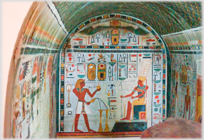 The last page was about the Egypt Museum in Cairo
The last page was about the Egypt Museum in Cairo
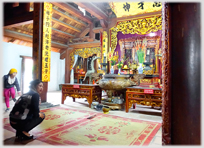 A page on a contemporary temple in Vietnam
A page on a contemporary temple in Vietnam
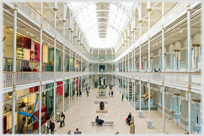 To a very different museum in Edinburgh
To a very different museum in Edinburgh
